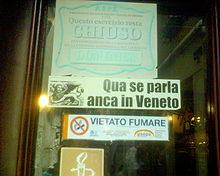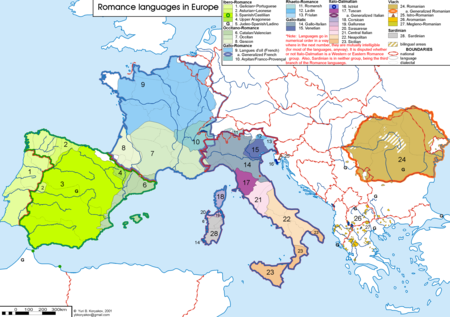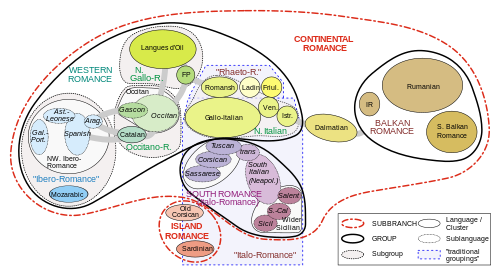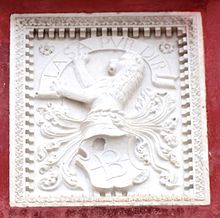Venetian language
| Venetian | |
|---|---|
| łengoa vèneta, vèneto | |
| Native to | Italy, Slovenia, Croatia |
| Region | |
Native speakers | 3.9 million (2002)[5] |
| Official status | |
Recognised minority language in | |
| Language codes | |
| ISO 639-3 | vec |
| Glottolog | vene1258 |
| Linguasphere | 51-AAA-n |
 | |


Venetian[7][8] or Venetan[9][10] (łéngoa vèneta [ˈe̯eŋgoa ˈvɛneta] or vèneto [ˈvɛneto]), is a Romance language spoken as a native language by Venetians, almost four million people in the northeast of Italy,[11] mostly in the Veneto region of Italy, where most of the five million inhabitants can understand it, centered in and around Venice, which carries the prestige dialect. It is sometimes spoken and often well understood outside Veneto, in Trentino, Friuli, the Julian March, Istria, and some towns of Slovenia and Dalmatia (Croatia) by a surviving autochthonous Venetian population, and Brazil, Argentina, Australia, and Mexico by Venetians in the diaspora.
Although referred to as an Italian dialect (Venetian: diałeto, Italian: dialetto) even by some of its speakers, Venetian is a separate language with many local varieties. Its precise place within the Romance language family remains controversial. However, both Ethnologue and Glottolog group it into the Gallo-Italic branch.[8][7]
History[]
Like all Italian dialects in the Romance language family, Venetian is descended from Vulgar Latin and influenced by the Italian language. Venetian is attested as a written language in the 13th century. There are also influences and parallelisms with Greek and Albanian in words such as piron (fork), inpirar (to fork), carega (chair) and fanela (T-shirt).
The language enjoyed substantial prestige in the days of the Republic of Venice, when it attained the status of a lingua franca in the Mediterranean Sea. Notable Venetian-language authors include the playwrights Ruzante (1502–1542), Carlo Goldoni (1707–1793) and Carlo Gozzi (1720–1806). Following the old Italian theatre tradition (commedia dell'arte), they used Venetian in their comedies as the speech of the common folk. They are ranked among the foremost Italian theatrical authors of all time, and plays by Goldoni and Gozzi are still performed today all over the world.
Other notable works in Venetian are the translations of the Iliad by Giacomo Casanova (1725–1798) and Francesco Boaretti, the translation of the Divine Comedy (1875) by Giuseppe Cappelli and the poems of Biagio Marin (1891–1985). Notable too is a manuscript titled Dialogo de Cecco di Ronchitti da Bruzene in perpuosito de la stella Nuova attributed to Girolamo Spinelli, perhaps with some supervision by Galileo Galilei for scientific details.[12]
Several Venetian–Italian dictionaries are available in print and online, including those by Boerio,[13] Contarini,[14] Nazari[15] and Piccio.[16]
As a literary language, Venetian was overshadowed by Dante Alighieri's Tuscan dialect (the best known writers of the Renaissance, such as Petrarch, Boccaccio and Machiavelli, were Tuscan and wrote in the Tuscan language) and languages of France like the Occitano-Romance languages and the langues d'oïl.
Even before the demise of the Republic, Venetian gradually ceased to be used for administrative purposes in favor of the Tuscan-derived Italian language that had been proposed and used as a vehicle for a common Italian culture, strongly supported by eminent Venetian humanists and poets, from Pietro Bembo (1470–1547), a crucial figure in the development of the Italian language itself, to Ugo Foscolo (1778–1827).
Virtually all modern Venetian speakers are diglossic with Italian. The present situation raises questions about the language's survival. Despite recent steps to recognize it, Venetian remains far below the threshold of inter-generational transfer with younger generations preferring standard Italian in many situations. The dilemma is further complicated by the ongoing large-scale arrival of immigrants, who only speak or learn standard Italian.
Venetian spread to other continents as a result of mass migration from Veneto between 1870 and 1905, and 1945 and 1960. This itself was a by-product of the 1866 Italian annexation and heavy taxations (tassa sul macinato/mill tax), because the latter subjected the poorest sectors of the population to the vagaries of a newly integrated, developing national industrial economy centered on north-western Italy. Tens of thousands of starving peasants and craftsmen were thrown off their lands or out of their workshops, forced to seek better fortune overseas.
Venetian migrants created large Venetian-speaking communities in Argentina, Brazil (see Talian), and Mexico (see Chipilo Venetian dialect), where the language is still spoken today. Internal migrations under the Fascist regime also deported many Venetian speakers to other regions of Italy, like southern Lazio.
Currently, some firms have chosen to use Venetian language in advertising as a famous beer did some years ago[clarification needed] (Xe foresto solo el nome, "only the name is foreign").[17] In other cases advertisements in Veneto are given a "Venetian flavour" by adding a Venetian word to standard Italian: for instance an airline used the verb xe (Xe sempre più grande, "it is always bigger") into an Italian sentence (the correct Venetian being el xe senpre pì grando)[18] to advertise new flights from Marco Polo Airport.[citation needed]
In 2007, Venetian was given recognition by the Regional Council of Veneto with regional law no. 8 of 13 April 2007 "Protection, enhancement and promotion of the linguistic and cultural heritage of Veneto".[19] Though the law does not explicitly grant Venetian any official status, it provides for Venetian as object of protection and enhancement, as an essential component of the cultural, social, historical and civil identity of Veneto.
Geographic distribution[]
This section needs additional citations for verification. (September 2015) |
Venetian is spoken mainly in the Italian regions of Veneto and Friuli-Venezia Giulia and in both Slovenia and Croatia (Istria, Dalmatia and the Kvarner Gulf).[citation needed] Smaller communities are found in Lombardy (Mantua), Trentino, Emilia-Romagna (Rimini and Forlì), Sardinia (Arborea, Terralba, Fertilia), Lazio (Pontine Marshes), and formerly in Romania (Tulcea).
It is also spoken in North and South America by the descendants of Italian immigrants. Notable examples of this are Argentina and Brazil, particularly the city of São Paulo and the Talian dialect spoken in the Brazilian states of Espírito Santo, São Paulo, Paraná, Rio Grande do Sul and Santa Catarina.
In Mexico, the Chipilo Venetian dialect is spoken in the state of Puebla and the town of Chipilo. The town was settled by immigrants from the Veneto region, and some of their descendants have preserved the language to this day. People from Chipilo have gone on to make satellite colonies in Mexico, especially in the states of Guanajuato, Querétaro, and State of Mexico. Venetian has also survived in the state of Veracruz, where other Italian migrants have settled since the late 19th century. The people of Chipilo preserve their dialect and call it chipileño, and it has been preserved as a variant since the 19th century. The variant of Venetian spoken by the Cipiłàn (Chipileños) is northern Trevisàn-Feltrìn-Belumàt.
In 2009, the Brazilian city of Serafina Corrêa, in the state of Rio Grande do Sul, gave Talian a joint official status alongside Portuguese.[20][21] Until the middle of the 20th century, Venetian was also spoken on the Greek Island of Corfu, which had long been under the rule of the Republic of Venice. Moreover, Venetian had been adopted by a large proportion of the population of Cephalonia, one of the Ionian Islands, because the island was part of the Stato da Màr for almost three centuries.[22]
Classification[]

Venetian is a Romance language and thus descends from Vulgar Latin. Its classification has always been controversial: According to Tagliavini, for example, it is one of the Italo-Dalmatian languages and most closely related to Istriot on the one hand and Tuscan–Italian on the other.[23] Some authors include it among the Gallo-Italic languages,[24] and according to others, it is not related to either one.[25] It should be however stressed that both Ethnologue and Glottolog group Venetian into the Gallo-Italic languages.[8][7]
Although the language region is surrounded by Gallo-Italic languages, Venetian does not share some traits with these immediate neighbors. Some scholars stress Venetian's characteristic lack of Gallo-Italic traits (agallicità)[26] or traits found further afield in Gallo-Romance languages (e.g. Occitan, French, Franco-Provençal)[27] or the Rhaeto-Romance languages (e.g. Friulian, Romansh). For example, Venetian did not undergo vowel rounding or nasalization, palatalize /kt/ and /ks/, or develop rising diphthongs /ei/ and /ou/, and it preserved final syllables, whereas, as in Italian, Venetian diphthongization occurs in historically open syllables. On the other hand, it is worth noting that Venetian does share many other traits with its surrounding Gallo-Italic languages, like interrogative clitics, mandatory unstressed subject pronouns (with some exceptions), the "to be behind to" verbal construction to express the continuous aspect ("El xé drìo magnàr" = He is eating, lit. he is behind to eat) and the absence of the absolute past tense as well as of geminated consonants.[28] In addition, Venetian has some unique traits which are shared by neither Gallo-Italic, nor Italo-Dalmatian languages, such as the use of the impersonal passive forms and the use of the auxiliary verb "to have" for the reflexive voice (both traits shared with German).[29]
Modern Venetian is not a close relative of the extinct Venetic language spoken in Veneto before Roman expansion, although both are Indo-European, and Venetic may have been an Italic language, like Latin, the ancestor of Venetian and most other languages of Italy. The earlier Venetic people gave their name to the city and region, which is why the modern language has a similar name.
Regional variants[]
The main regional varieties and subvarieties of Venetian language outside of Venice are:
- Central (Padua, Vicenza, Polesine), with about 1,500,000 speakers
- Eastern/Coastal (Trieste, Grado, Istria, Fiume)
- Western (Verona, Trentino)
- Northern Sinistra Piave of the Province of Treviso, most of the Province of Pordenone)
- North-Central Destra Piave of the Province of Treviso, (Belluno, comprising Feltre, Agordo, Cadore, and Zoldo Alto)
All these variants are mutually intelligible, with a minimum 92% in common among the most diverging ones (Central and Western). Modern speakers reportedly can still understand Venetian texts from the 14th century to some extent.
Other noteworthy variants are:
- the variety spoken in Chioggia
- the variety spoken in the Pontine Marshes
- the variety spoken in Dalmatia
- the Talian dialect of Antônio Prado, Entre Rios, Santa Catarina and Toledo, Paraná, among other southern Brazilian cities
- the Chipilo Venetian dialect (Spanish: Chipileño) of Chipilo, Mexico
- Peripheral creole languages along the southern border (nearly extinct)
Grammar[]


Like most Romance languages, Venetian has mostly abandoned the Latin case system, in favor of prepositions and a more rigid subject–verb–object sentence structure. It has thus become more analytic, if not quite as much as English. Venetian also has the Romance articles, both definite (derived from the Latin demonstrative ille) and indefinite (derived from the numeral unus).
Venetian also retained the Latin concepts of gender (masculine and feminine) and number (singular and plural). Unlike the Gallo-Iberian languages, which form plurals by adding -s, Venetian forms plurals in a manner similar to standard Italian. Nouns and adjectives can be modified by suffixes that indicate several qualities such as size, endearment, deprecation, etc. Adjectives (usually postfixed) and articles are inflected to agree with the noun in gender and number, but it is important to mention that the suffix might be deleted because the article is the part that suggests the number. However, Italian is influencing Venetian language:
| Venetian | Veneto dialects | Italian | English |
|---|---|---|---|
| el gato graso | el gato graso | il gatto grasso | the fat (male) cat |
| la gata grasa | ła gata grasa | la gatta grassa | the fat (female) cat |
| i gati grasi | i gati grasi | i gatti grassi | the fat (male) cats |
| le gate grase | łe gate grase | le gatte grasse | the fat (female) cats |
In recent studies on Venetian variants in Veneto, there has been a tendency to write the so-called "evanescent L" as ⟨ł⟩. While it may help novice speakers, Venetian was never written with this letter. In this article, this symbol is used only in Veneto dialects of Venetian language. It will suffice to know that in Venetian language the letter L in word-initial and intervocalic positions usually becomes a "palatal allomorph", and is barely pronounced.[30]
No native Venetic words seem to have survived in present Venetian, but there may be some traces left in the morphology, such as the morpheme -esto/asto/isto for the past participle, which can be found in Venetic inscriptions from about 500 BC:
- Venetian: Mi A go fazesto ("I have done")
- Venetian Italian: Mi A go fato
- Standard Italian: Io ho fatto
Redundant subject pronouns[]
A peculiarity of Venetian grammar is a "semi-analytical" verbal flexion, with a compulsory "clitic subject pronoun" before the verb in many sentences, "echoing" the subject as an ending or a weak pronoun. Independent/emphatic pronouns (e.g. ti), on the contrary, are optional. The clitic subject pronoun (te, el/ła, i/łe) is used with the 2nd and 3rd person singular, and with the 3rd person plural. This feature may have arisen as a compensation for the fact that the 2nd- and 3rd-person inflections for most verbs, which are still distinct in Italian and many other Romance languages, are identical in Venetian.
| Venetian | Italian | English |
|---|---|---|
| Mi go | Io ho | I have |
| Ti ti ga | Tu hai | You have |
| Venetian | Italian | English |
|---|---|---|
| Mi so | Io sono | I am |
| Ti ti xe | Tu sei | You are |
The Piedmontese language also has clitic subject pronouns, but the rules are somewhat different. The function of clitics is particularly visible in long sentences, which do not always have clear intonational breaks to easily tell apart vocative and imperative in sharp commands from exclamations with "shouted indicative". For instance, in Venetian the clitic el marks the indicative verb and its masculine singular subject, otherwise there is an imperative preceded by a vocative. Although some grammars regard these clitics as "redundant", they actually provide specific additional information as they mark number and gender, thus providing number-/gender- agreement between the subject(s) and the verb, which does not necessarily show this information on its endings.
Interrogative inflection[]
Venetian also has a special interrogative verbal flexion used for direct questions, which also incorporates a redundant pronoun:
| Venetian | Veneto dialects | Italian | English |
|---|---|---|---|
| Ti geristu sporco? | (Ti) jèristu onto? or (Ti) xèrito spazo? |
(Tu) eri sporco? | Were you dirty? |
| El can, gerilo sporco? | El can jèreło onto? or Jèreło onto el can ? |
Il cane era sporco? | Was the dog dirty? |
| Ti te gastu domandà? | (Ti) te sito domandà? | (Tu) ti sei domandato? | Did you ask yourself? |
Auxiliary verbs[]
Reflexive tenses use the auxiliary verb avér ("to have"), as in English, Scandinavian, Spanish, Romanian and Neapolitan; instead of èssar ("to be"), which would be normal in Italian. The past participle is invariable, unlike Italian:
| Venetian | Veneto dialects | Italian | English |
|---|---|---|---|
| Ti ti te ga lavà | (Ti) te te à/gà/ghè lavà | (Tu) ti sei lavato | You washed yourself |
| (Lori) i se ga desmissià | (Lori) i se gà/à svejà | (Loro) si sono svegliati | They woke up |
Continuing action[]
Another peculiarity of the language is the use of the phrase eser drìo (literally, "to be behind") to indicate continuing action:
| Venetian | Veneto dialects | Italian | English |
|---|---|---|---|
| Me pare, el ze drìo parlàr | Mé pare 'l ze drìo(invià) parlàr | Mio padre sta parlando | My father is speaking |
Another progressive form in some Venetian dialects uses the construction èsar łà che (lit. "to be there that"):
- Venetian dialect: Me pare l'è là che'l parla (lit. "My father he is there that he speaks").
The use of progressive tenses is more pervasive than in Italian; e.g.
- English: "He wouldn't have been speaking to you".
- Venetian: No'l sarìa miga sta drio parlarte a ti.
That construction does not occur in Italian: *Non sarebbe mica stato parlandoti is not syntactically valid.
Subordinate clauses[]
Subordinate clauses have double introduction ("whom that", "when that", "which that", "how that"), as in Old English:
| Venetian | Veneto dialects | Italian | English |
|---|---|---|---|
| Mi so de chi che ti parli | So de chi che te parli | So di chi parli | I know who you are talking about |
As in other Romance languages, the subjunctive mood is widely used in subordinate clauses.
| Venetian | Veneto dialects | Italian | English |
|---|---|---|---|
| Mi credeva che'l fuse ... | Credéa/évo che'l fuse ... | Credevo che fosse ... | I thought he was ... |
Phonology[]
Consonants[]
| Labial | Dental | Alveolar | Post-alv. /Palatal |
Velar | ||
|---|---|---|---|---|---|---|
| Nasal | m | n | ɲ | ŋ | ||
| Plosive | voiceless | p | t | k | ||
| voiced | b | d | ɡ | |||
| Affricate | voiceless | (t͡s) | t͡ʃ | |||
| voiced | (d͡z) | d͡ʒ | ||||
| Fricative | voiceless | f | (θ) | s | ||
| voiced | v | (ð) | z | |||
| Tap | ɾ | |||||
| Approximant | w | l | j | (ɰ) | ||
Some dialects of Venetian have certain sounds not present in Italian, such as the interdental voiceless fricative [θ], often spelled with ⟨ç⟩, ⟨z⟩, ⟨zh⟩, or ⟨ž⟩, and similar to English th in thing and thought. This sound occurs, for example, in çéna ("supper", also written zhena, žena), which is pronounced the same as Castilian Spanish cena (which has the same meaning). The voiceless interdental fricative occurs in Bellunese, north-Trevisan, and in some Central Venetian rural areas around Padua, Vicenza and the mouth of the river Po.
Because the pronunciation variant [θ] is more typical of older speakers and speakers living outside of major cities, it has come to be socially stigmatized, and most speakers now use [s] or [ts] instead of [θ]. In those dialects with the pronunciation [s], the sound has fallen together with ordinary ⟨s⟩, and so it is not uncommon to simply write ⟨s⟩ (or ⟨ss⟩ between vowels) instead of ⟨ç⟩ or ⟨zh⟩ (such as sena).
Similarly some dialects of Venetian also have a voiced interdental fricative [ð], often written ⟨z⟩ (as in el pianze 'he cries'); but in most dialects this sound is now pronounced either as [dz] (Italian voiced-Z), or more typically as [z] (Italian voiced-S, written ⟨x⟩, as in el pianxe); in a few dialects the sound appears as [d] and may therefore be written instead with the letter ⟨d⟩, as in el piande.
Some varieties of Venetian also distinguish an ordinary [l] vs. a weakened or lenited ("evanescent") ⟨l⟩, which in some orthographic norms is indicated with the letter ⟨ł⟩;[31] in more conservative dialects, however, both ⟨l⟩ and ⟨ł⟩ are merged as ordinary [l]. In those dialects that have both types, the precise phonetic realization of ⟨ł⟩ depends both on its phonological environment and on the dialect of the speaker. Typical realizations in the region of Venice include a voiced velar approximant or glide [ɰ] (usually described as nearly like an "e" and so often spelled as ⟨e⟩), when ⟨ł⟩ is adjacent (only) to back vowels (⟨a o u⟩), vs. a null realization when ⟨ł⟩ is adjacent to a front vowel (⟨i e⟩).
In dialects further inland ⟨ł⟩ may be realized as a partially vocalised ⟨l⟩. Thus, for example, góndoła 'gondola' may sound like góndoea [ˈɡoŋdoɰa], góndola [ˈɡoŋdola], or góndoa [ˈɡoŋdoa]. In dialects having a null realization of intervocalic ⟨ł⟩, although pairs of words such as scóła, "school" and scóa, "broom" are homophonous (both being pronounced [ˈskoa]), they are still distinguished orthographically.
Venetian, like Spanish, does not have the geminate consonants characteristic of standard Italian, Tuscan, Neapolitan and other languages of southern Italy; thus Italian fette ("slices"), palla ("ball") and penna ("pen") correspond to féte, bała, and péna in Venetian. The masculine singular noun ending, corresponding to -o/-e in Italian, is often unpronounced in Venetian after continuants, particularly in rural varieties: Italian pieno ("full") corresponds to Venetian pien, Italian altare to Venetian altar. The extent to which final vowels are deleted varies by dialect: the central–southern varieties delete vowels only after /n/, whereas the northern variety delete vowels also after dental stops and velars; the eastern and western varieties are in between these two extremes.
The velar nasal [ŋ] (the final sound in English "song") occurs frequently in Venetian. A word-final /n/ is always velarized, which is especially obvious in the pronunciation of many local Venetian surnames that end in ⟨n⟩, such as Marin [maˈɾiŋ] and Manin [maˈniŋ], as well as in common Venetian words such as man ([ˈmaŋ] "hand"), piron ([piˈɾoŋ] "fork"). Moreover, Venetian always uses [ŋ] in consonant clusters that start with a nasal, whereas Italian only uses [ŋ] before velar stops: e.g. [kaŋˈtaɾ] "to sing", [iŋˈvɛɾno] "winter", [ˈoŋzaɾ] "to anoint", [ɾaŋˈdʒaɾse] "to cope with".[32]
Speakers of Italian generally lack this sound and usually substitute a dental [n] for final Venetian [ŋ], changing for example [maˈniŋ] to [maˈnin] and [maˈɾiŋ] to [maˈrin].
Vowels[]
| Front | Central | Back | |
|---|---|---|---|
| Close | i | u | |
| Close-mid | e | o | |
| Open-mid | ɛ | (ɐ) | ɔ |
| Open | a |
An accented á can also be pronounced as [ɐ]. An intervocalic /u/ can be pronounced as a [w] sound.
Prosody[]
While written Venetian looks similar to Italian, it sounds very different, with a distinct lilting cadence, almost musical. Compared to Italian, in Venetian syllabic rhythms are more evenly timed, accents are less marked, but on the other hand tonal modulation is much wider and melodic curves are more intricate. Stressed and unstressed syllables sound almost the same; there are no long vowels, and there is no consonant lengthening. Compare the Italian sentence va laggiù con lui [val.ladˌd͡ʒuk.konˈluː.i] "go there with him" (all long/heavy syllables but final) with Venetian va là zo co lu [va.laˌzo.koˈlu] (all short/light syllables).[33]
Sample etymological lexicon[]
As a direct descent of regional spoken Latin, Venetian lexicon derives its vocabulary substantially from Latin and (in more recent times) from Tuscan, so that most of its words are cognate with the corresponding words of Italian. Venetian includes however many words derived from other sources (such as Greek, Gothic, and German), and has preserved some Latin words not used to the same extent in Italian, resulting in many words that are not cognate with their equivalent words in Italian, such as:
| English | Italian | Venetian (DECA) | Venetian word origin |
|---|---|---|---|
| today | oggi | uncò, 'ncò, incò, ancò, ancúo, incoi | from Latin hunc + hodie |
| pharmacy | farmacia | apotèca | from Ancient Greek ἀποθήκη (apothḗkē) |
| to drink | bere | trincàr | from German trinken "to drink" |
| apricot | albicocca | armelín | from Latin armenīnus |
| to bore | dare noia, seccare | astiàr | from Gothic WIKI |